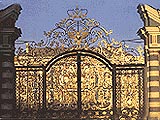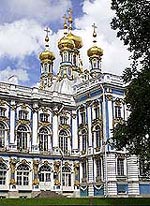Pearls of Russia
Museums and memorial estates
 Tsarskoe Selo
Tsarskoe Selo
State Museum Reserve "Tsarskoe Selo" is a brilliant monument of world architecture and park and garden artistry of the 18th-20th centuries.
A magnificent group of architects, sculptors and painters brought the desires of their royal clients here. In "Tsarskoe Selo" the full range of artistic styles is represented, from the Baroque (in buildings by Bartolomeo Francesco Rastrelli) and Classical eras (buildings by Ch. Cameron, G. Quarenghi, V. Stasov and others).
Imperial rulers from Catherine I to Nicholas II have left their mark on "Tsarskoe Selo". The compositional center of the ensemble is the Catherine Palace, a magnificent baroque-style palace.
The Great Hall of the palace and the Golden Enfilade of formal halls, among which - well-known Amber Room, amaze with the luxury of their decoration. When you enter the palace halls, you will sense the spirit of Elizabeth and Catherine eras, and see rare objects of applied art.
Alexander Palace is one of the best examples of world architecture in classical style. Passing through the rooms of Emperor Nicholas II and his wife Alexandra Fyodorovna you will come up close to artistic tastes of the last Romanovs, and view the Emperor's State Study, decorated in fin-de-siecle style.
More than 100 architectural objects with a total area of 300 hectares occupy the territory of the Catherine and Alexander Parks: from magnificent palaces and monuments, to pavilions and bridges, marble monuments, exotic constructions designed to imitate gothic style, Turkish and Chinese architecture which lend the park a romantic air.
A Brief History of "Tzarskoe Selo"
The emergence and foundations for the further development of "Tsarskoe Selo" are connected with the liberation of ancient Novgorodian lands on the banks of the Neva river from Swedish occupation, construction of St. Petersburg and its transformation into capital of Russian state.
This territory was long a part of the medieval Russian State. In the 12th century these lands were called the "Izhorsk land of the ruler of Novgorod the Great." In the 17th century this "Izhorsk land" was occupied by the Swedes. The return of these territories to Russia began as a result of victories at the start of the Northern War in 1702.
On a place of the future "Tsarskoe Selo" there was a small manor - Saris hoff, Saaris Moisio.
First Sarskaya Muza was given as a gift to Governor General of the Liberated Region, Alexander Menshikov, then on July 24, 1710, by order of Peter the Great, the manor was "bequeathed" to his bride-to-be, Ekaterina Alexeevna, and given the status of court lands. Peter the Great's official wedding ceremony took place in February, 1712. In 1710-1720-s, a royal country residence appeared in place of the old estate. Russian villages grew up around it. In 1719 - 1720, near the hillock, on the territory of the future town, there emerged a settlement of palace servants. They began to call Sarskaya Myza "Sarskoje Selo," and with palace construction beginning, the name became Tsarskoe Selo.
For two centuries, Tsarskoe Selo was considered the imperial summer residence. Its construction was of state significance and took many years with the participation of government agencies.
After the October Revolution the palace and park ensemble was turned into a museum, and the best houses in the town were occupied by educational and health institutions. So, in 1918 the town was renamed Detskoje Selo. In 1937, on the 100-year anniversary of the tragic death of poet Alexander Pushkin, the town received its present name.
In January 1983 Council of Ministers of the Russian Federation issued a decree giving the palaces and parks of Pushkin the status of a reserve, which in 1990 was called the "Tsarskoe Selo" State Museum Reserve.
 The unique part of a collection
The unique part of a collection
Nowadays the State museum - reserve "Tsarskoe Selo" accounts more than 20 thousand exhibits. Among them unique things from the following collections:
Collections of painting of the West-European artists of XVI - XX and Russian artists of XVIII - XIX centuries;
collections of water colors of L. Prematstsi, E.Gau and well-known Russian artists of XVIII - XIX centuries. and graphic of English engravers of XVIII - XIX centuries.
Collections of furniture of Russian, West-European and east masters of XVIII - XX centuries.; arts and crafts collection: products of Russian and West-European porcelain of XVIII - the beginning of XX centuries, Chinese and east porcelain of XVII - XX cent., Russian and West-European faience products of XVII - the beginning of XX centuries, glass products made at Russian and European factories in XVIII-XX centuries.
Collections of amber products of West-European and Russian masters - XVII - XIX centuries; collections of art metal of Russian and West-European masters of XVIII-XIX centuries; collections of weapon belonging to Russian emperors and memorial things of XV-XIX centuries from India, Africa, countries of Caucasus, Persia and Turkey.
Collections of suit and the fabrics, consisting of military uniforms of imperial family, carpets, portieres, samples of fabrics from stage of emperor Peter the III till stage of emperor Nikolay the II;
collections of sculpture: marble - Italian masters of the beginning of XVIII cent., bronze and galvanic-plastic of Russian masters of XVIII - XIX centuries;
collections of rare books including rare editions of XVI - XIX cent. and books from Catherine and Alexander Palaces libraries.
|